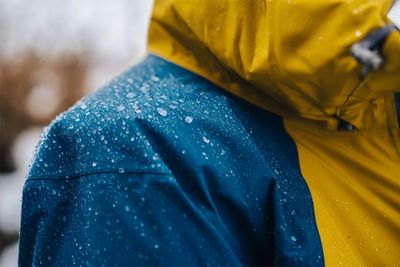Contents
Waterproof? Not Without DWR!
We’ve all been there: You set out on a hike in high spirits, but the moment the rain starts, your jacket gets soaked - despite the label clearly saying "waterproof"! Here's why that happens - and how DWR coating plays a crucial role.
What is a DWR Coating?
DWR stands for Durable Water Repellency. It refers to a special, usually transparent finish applied to the outer surface of outdoor garments.
Its job? To make water bead up and roll off instead of soaking into the fabric. At the same time, it preserves the garment’s breathability - a big plus when you're working up a sweat.
>> Discover high-performance rain jackets with durable DWR finishes

Why Does My Jacket Lose Its Water-Repellency Over Time?
Even the best DWR treatment doesn't last forever. Here's what can wear it down:
- Friction from backpack straps or washing
- Dirt and body oils building up on the fabric
- Exposure to UV rays and weather degrading the coating
The result? Your jacket starts to "wet out" - meaning water no longer beads but instead soaks into the outer fabric. While the membrane underneath (like GORE-TEX®) still keeps water out, the jacket feels damp and cold.
Restoring DWR - How to Make Your Jacket Weather-Ready Again
The good news: You can easily revive its water-repellent powers! Here’s how:
Step-by-step guide:
1. Clean: Wash your jacket using a gentle cycle, a specialized outdoor detergent, and no fabric softener.
2. Reactivate: Many DWR coatings can be reactivated with heat. After washing, tumble-dry on low (check the care label first!).
3. Reproof (if needed):
Spray-on treatment: Great for targeting high-wear areas like shoulders and sleeves.
Wash-in treatment: Covers the whole garment, though it may slightly reduce breathability since it also coats the inner side.
Tip: For the planet’s sake, go for PFC-free reproofing products.

Sustainability & DWR – Do They Go Together?
Traditional DWR coatings often contain PFCs (per- and polyfluorinated chemicals), which are harmful to both health and the environment.
That’s why more and more brands - like Fjällräven, Mammut, Ternua, and Houdini - are switching to PFC-free, biodegradable alternatives for a more eco-friendly approach to staying dry.
Bottom Line: DWR Protects You - And Your Gear
DWR might be invisible, but its impact is huge. It keeps you dry, protects your gear, and - if you choose sustainable options - it can even be eco-conscious.
With the right care, your outdoor jacket will stay functional longer and be your reliable companion on every adventure.
- DWR coatings make water bead off - essential for comfort and warmth
- Its effect fades over time - but can be easily reactivated
- Eco-friendly, PFC-free products are better for health and environment
- Regular maintenance extends the life of your gear
FAQs About DWR Coating
How often should I reproof my jacket?
Roughly every 10–15 washes, or whenever water stops beading on the surface.
Is DWR the same as being waterproof?
No. DWR is just a water-repellent finish. True waterproofing comes from the membrane inside (like GORE-TEX® or Sympatex®).
Does reproofing damage the fabric?
Not at all—quite the opposite! Regular reproofing actually helps extend your jacket’s lifespan.
More articles you might like:
>> PFC-Free: Stay Dry Without Harmful Chemicals
>> GORE-TEX: The Tiny Membrane That Does Big Things
>> No-Nonsense Guide: Must-Have Features in a Rain Jacket
>> What’s a Water Column Rating—And Why Should You Care?

